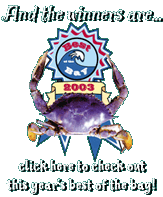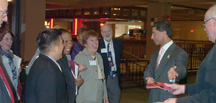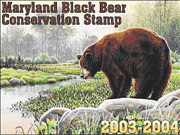
|
Dock of the Bay
The Breakdown
Faster than Isabel, the U.S. Sailboat Show yields to the Powerboat Show.
Several days of solid back-to-back shift work bring Annapolis the Sailboat Show. Breaking it all down takes a lot less time. In the blink of an eye, sailboats file out. The banners covering the show’s chain-link perimeter go from promoting sail to powerboat products, and Ego Alley is chock-a-block with tubby yachts.
It’s called breakdown — but how do they do it so quickly?
The first priority for the water crew is to get the boats out. Their plan is to work their way to Ego Alley by 6:30pm.
As the water crew — men and women young and older lent from Annapolis Sailing School — gather, glow sticks are passed around so crew can see each other in the dark, which falls early this time of year. Dock Master Tim Dowling warns his crew that safety is paramount. “No boats are allowed to cast off until the gun sounds at 5pm,” he says. “But if boats due try and cast off early, do not try to physically restrain them, let them go.”
 |
photo by Kimberly Gooode
Tom MacGarry maneuvres a sailboat toward its getaway. |
At 4:45pm the water crew takes their positions. Like hungry sharks surrounding their prey, their Carolina Skiffs circle in the water. The remaining crew man the floating docks, wrenches in hands and radios at the ready. If your on the docks, you’re a worker. I’m a reporter, but if I’m handed a wrench and told to take apart a dock, I’d better do it.
At 5pm, it’s mass exodus as the gun sounds to officially end the U.S. Sailboat Show and bring in the U.S. Powerboat Show. On the docks, it feels like being in the grocery store at rush hour going against the traffic to make it back to the produce aisle to retrieve apples. The next couple of hours race against the clock.
The first boats to cast off and motor into the harbor are the elegant Beneteau yachts on the outside rail. The remaining outer boats, also the largest, speed away as workers scramble to clear lanes among the floating docks.
The crew scurries along sweating. Workboats turn and spin in the water to move docks and pull out those few boats that don’t have engines. The crew will be at Ego Alley in no time if they keep up this pace. But first, they have to disassemble the docks to create passages for the remaining boats to maneuver through.
Christopher Cross’s famous sailing song “Southern Cross” blares from Pusser’s Landing as onlookers hoot and holler at the few civilians stuck in the middle of the floating docks. On first and second floors at the Spa Creek side of Annapolis Waterfront Marriott, Pusser’s is the place to be. People are crammed in as if it were an elevator in a tall building at 5pm. The bar bell rings every time a new square of dock is disassembled. Like spectators at a football game, the crowd cheers the crew on.
 |
photo by Kimberly Gooode
Exhibitors pack up their wares and head out. |
At 6:15, they are ahead of schedule and ready to break down Ego Alley. Peeling away the docks, they have the last boats lined up and ready to roll. The dock is separated and the first boat hits the gas like the Indy 500, speeding off as the crowd cheers.
Ego Alley is a tight space. With a temporary piling dividing the waterway and a hairpin turn between two floating docks at the end of the alley, boaters must be alert and careful.
“This is where it gets tricky. If they pick up too much speed, they won’t make the turn and the crowd starts shouting and booing. Sometimes they will bump the dock. It’s a tight space for boats this size,” says a Navtek sales rep.
The crowd cheers them along, chanting and clapping. Much like a beauty contest, each boat attempts to garner applause as it glides past the rowdy crowd. So frenzied is the display that one boater lifts his shirt to show some skin. Spectators, especially women, go crazy.
It’s every boater’s hope to meander gracefully through this maze of floating docks. One 46-footer nearly brushes Pusser’s dock with its stern as it spins around to depart in reverse with its sails up. The crowd eggs him on, shouting “no wind.” Time passes happily as the crowd waits for the last boat to push off.
Once again, breakdown is as awesome a display as a well-choreographed water ballet. The alcohol-warmed crowd adds spice to the movements. As the last boat makes its way along Ego Alley, a loud roar erupts from Pusser’s. The Hunter 36 trolls along until it finds an open spot. Slowly it turns left and moves through the opening of two floating docks, heading for open water. The first phase of the U.S Boat Show is over. It is 7:15pm.
— Kimberly Goode
to the top
In Season: Apples
Story and art by Gary Pendleton
October is the time to enjoy the wholesome fruit of the apple tree. Whether served in a pie, made into sauce or taken raw, apples are the essential American fruit. No native fruit — neither the persimmon, nor blueberry nor cranberry — is more closely associated with this country than the apple.
But like so many of us Americans, the apple is an immigrant. Crab apple trees are native to the U.S., but the domestic apple, of which there are many varieties, is an Asian migrant.
 In The Botany of Desire, Michael Pollan describes how the apple has relied on assistance from humans to adapt itself to a wide range of climates throughout the world. Like my ancestors, and perhaps yours, the forebearers of the domesticated apple were not native to this continent. The wild apple species that is the progenitor of the many varieties of domestic apples we enjoy comes from Kazakhstan. One of Pollan’s themes is that in America, the apple adapted to domestic soils and climates just as early immigrants did. Adaptation resulted in new apple varieties as distinct from their ancestors as the American people were distinct from Europeans. In The Botany of Desire, Michael Pollan describes how the apple has relied on assistance from humans to adapt itself to a wide range of climates throughout the world. Like my ancestors, and perhaps yours, the forebearers of the domesticated apple were not native to this continent. The wild apple species that is the progenitor of the many varieties of domestic apples we enjoy comes from Kazakhstan. One of Pollan’s themes is that in America, the apple adapted to domestic soils and climates just as early immigrants did. Adaptation resulted in new apple varieties as distinct from their ancestors as the American people were distinct from Europeans.
Well known American varieties include York, Stayman Winesap, Red Delicious and Grimes Golden. If you want a good baking apple for your truly American apple pie, use Arkansas Black or Idared if you can find them; avoid the Australian bred Granny Smith.
An odd characteristic of apple trees is that they do not grow “true” from seed. If you plant an apple seed, it should bear fruit in six or seven years, but the apples it produces will be very different from its parent and almost certainly unfit for eating. An apple tree is capable of producing tens of thousands of seeds within a normal life span. If all those seeds were planted, each tree would produce fruit possessing varying qualities of sweetness, juiciness, firmness, etc. Few if any would be good for anything except making cider. Still, this abundance of genetic variety is one reason the apple adapts so well to a wide range of conditions.
Only one seed in a million, give or take a few thousand, has the combination of genes to produce a tree capable of bearing fruit in the same class as a Jonogold, Stayman or Rome Beauty. When such a tree emerges from the ranks of the bitter and sour, it can only be reproduced by grafting a branch onto the trunk of another tree.
In the early 20th century, the discovery of a good-tasting apple variety was the equivalent of discovering oil. A farmer who produced such a tree could strike it rich by licensing and marketing a successful variety. Today, many old-fashioned varieties are difficult to find. They have lost out to a small number of relatively bland but pretty varieties that ship and store well, qualities that chain grocery stores prefer over taste.
It can be fun to visit orchards with roadside stands to seek out unusual varieties. Southern Maryland is not blessed with an abundance of orchards, but there are a few. On Rt. 231 in Charles County, George Rabbitt operates Benedict Orchard. Among the 500-plus apple trees, there are some unusual varieties worth seeking out, such as the Turley Winesap and Black Twig. The Macoun is a small, tart green variety that has inspired a group of enthusiastic consumers, according to orchardist Rabbitt.
Find Benedict Orchard at 16950 Prince Frederick Rd., about two miles west of the Benedict Bridge.
to the top
Gambling on Gambling: A New Deal
Racetracks play its hand to win slots game
The deck of cards has been dealt and the players at the table are wrangling to outwit their opponent. In this round, the players are the Maryland Jockey Club partnered with the Magna Entertainment Corporation from Ontario, Canada, up against the Maryland House Ways and Means Committee. The winner may be decided by who holds the best hand — or who bluffs the best.
Meanwhile Rosecroft Raceway in Prince Georges County is playing its own hand [“Gambling on Gambling,” Vol. XI., No 37: Sept. 11].
The stakes are high as video lottery terminals — slots — are the reward for victory.
The Maryland Jockey Club and Magna Entertainment showed their hand earlier this month while hosting the Maryland House Ways and Means Committee at Laurel and Pimlico racetracks to show how slots would improve business at the two tracks.
“We want a level playing field to compete with West Virginia, Delaware and Pennsylvania once they approve slots legislation,” said Joseph A. De Francis, president of the Maryland Jockey Club, which owns and operates both racetracks.
 |
photo by James Clemenko
Joseph A. De Francis, second from right, president of the Maryland Jockey Club, which owns and operates Laurel and Pimlico racetracks, makes his pitch for 7,000 slot machines at the two tracks to Maryland House Ways and Means Committee members. |
Leveling the playing field would give the Maryland Jockey Club the legal right to place a total of 7,000 slot machines at the two tracks. With the increased revenue, De Francis said they would rebuild the tracks to improve the draw and, in the end, profits.
More revenue would stabilize the trend of decreasing profits at Laurel and Pimlico racetracks, according to Jim McAlpine, president of Magna Entertainment Corporation, which owns a minority share in the two tracks.
“Magna’s strategies are to rebuild and acquire new racetracks to provide continuous wagering to increase distribution for international off-track betting,” said McAlpine.
Both the growth of off-track betting and increased traffic to Laurel and Pimlico racetracks are goals for Magna. To get there, Magna is proposing to rebuild both racetracks.
At Laurel, the partners would build a new clubhouse and grandstand on the opposite side of the track. The track would also be reconfigured.
“A turf course is the name of the game to increase the number of races and horses,” said McAlpine. “The turf track needs to be wider and longer to make it more profitable.” Other modifications would include rebuilding a new stable area on property recently purchased by the Maryland Jockey Club.
The overhaul would be complete at Pimlico, the current home to the second leg of the Triple Crown, the Preakness.
But there’s a catch.
“Video lottery terminals are important for upgrades to occur. They will determine what is built at each track and the time frame for completion,” said De Francis. If slots are approved, Laurel and Pimlico could generate $750 million in gross non-tax revenue.
What else would those profits lead to?
Laurel and Pimlico would become destination points attracting horse racing fans and anyone else wanting the thrill of risk through gambling, McAlpine and De Francis agree. Money would also be spent on the Preakness. New developments at both tracks would create jobs and bring money back to Maryland, according to Magna.
The Maryland Jockey Club and Magna Entertainment have come to the table and have shown their cards.
The hand dealt to the Maryland House Ways and Means Committee is no secret: They hold the key for slots legislation in the state. In 2003, the Committee shot down legislation for slots 16-5.
If legislation is passed by the Maryland General Assembly approving slots as legal gambling, Laurel and Pimlico racetracks will change in big ways.
In the next session for the Maryland General Assembly, both tension and the stakes will rise.
— James Clemenko
to the top
Way Downstream…
In Baltimore, the U.S. Geological Survey told us something last week we already knew: that the past year was very wet. How wet? It was the second-highest flow into the Chesapeake Bay since record-keeping started in 1937 and the most since 1972, when Bay Country was flogged by Tropical Storm Agnes…
 In Western Maryland, hunters will be aiming at black bears for the first time in a half-century — legally, anyway. DNR last week said the hunt was authorized to thin out a bear population that has doubled since 1995 to somewhere between 300 to 400. Conservationists argue that the hunt does nothing about the “problem” bears that have generated complaints… In Western Maryland, hunters will be aiming at black bears for the first time in a half-century — legally, anyway. DNR last week said the hunt was authorized to thin out a bear population that has doubled since 1995 to somewhere between 300 to 400. Conservationists argue that the hunt does nothing about the “problem” bears that have generated complaints…
In Delaware, Gov. Tom Carper announced last week that a citizens’ committee will start deciding where to place the state’s first national park. Among the potential sites are: Fort Delaware; Fort Dupont; the Mason-Dixon Line or somewhere associated with the Underground Railroad. Delaware is the only state without a national park…
In Delray Beach, Fla., Office Depot recently turned up the heat on unscrupulous paper-providers, saying it will stop doing business with suppliers that harm the environment and give preference to companies committed to sustainable forestry…
In Rwanda, authorities are trying to rebuild tourism after the civil strife and genocide of the 1990s. Starting in November, the Primate Discovery Tour will let people get close to rare mountain gorillas and to talk to researchers studying them…
Our Creature Feature comes from Germany, where people are protesting the plan to put the body of a gorilla named Artist in the controversial Body Worlds Exhibition that features corpses of humans and many animals.
Animal rights advocates charge that Body Worlds, which is now appearing in Hamburg, is a freak show with its chemicaly preserved bodies of humans and animals. They think that it’s a good time to make a stand now that the German owners want to include the 450-pound body of the popular gorilla, which drowned at the Hanover Zoo in 1999.
to the top
|
|